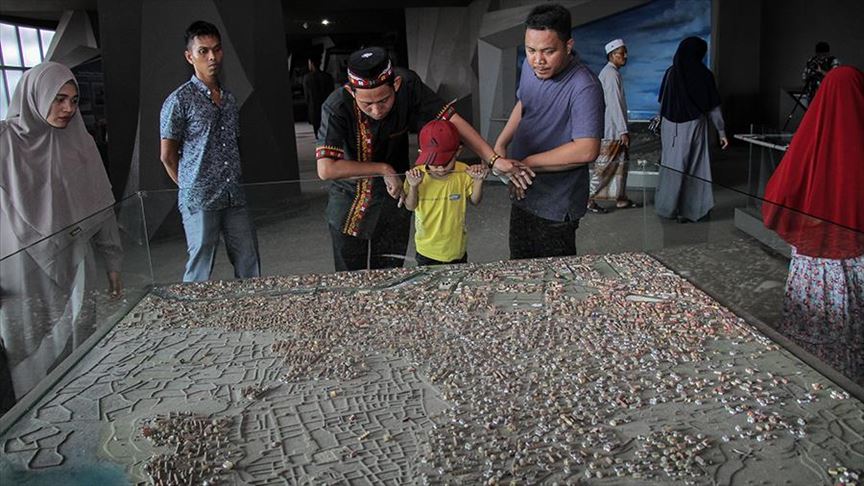Aceh Tsunami Museum serves as memorial to tragedy
Museum established to provide disaster education, especially for younger generation

ACEH, Indonesia
Muhammad Daud will never forget the horrific experience 15 years ago when a tsunami swept through Aceh province, killing more than 200,000 people.
"At the time, I felt that the world was about to come to an end," he told Anadolu Agency.
On the morning of Dec. 26, 2004, Daud went fishing with his colleagues. Suddenly, he felt the ground shaking.
“The shaking initially felt slow but gradually became longer and faster and lasted up to 10 minutes. I saw with my own eyes the shaking turning the ground into mush,” he said.
“Then I saw muddy water spurting out from a crack. It was as high as a palm tree.”
Fortunately, he managed to save himself along with his wife and children, and they took refuge in a mosque.
Education for disaster preparedness
Established in 2009, the Aceh Tsunami Museum became home to a collection of relics and debris recovered from that fateful day.
In front of the museum, located on Jalan Taman Blang Padang, the wreckage of trucks destroyed by the tsunami can be seen.
Visitors are greeted at the entrance with "Lorong Tsunami", or "Tsunami Alley", a dark passageway flanked by walls as high as 40 meters (131 feet) down which water flows, which was built to recreate the horrors of the tsunami.
The museum also has a room called "Sumur Doa". Inside the room, both victims and survivors’ names are engraved on the walls.
Hafnidar, the head of the museum, who like many Indonesians goes by one name, said she wanted to provide disaster education, especially for the younger generation.
According to her, many young people born after 2004 lacked information about the disaster.
"Moreover, Aceh and Indonesia are disaster-prone areas. Educating the younger generation is an essential task,” she said, adding the museum does not merely exhibit objects but also the messages behind them.
"We want to promote values, as it is one of the characteristics of 21st Century museums," she added.
Currently, disaster mitigation campaigners from 600 junior high schools have been assembling to provide education on disaster preparedness.
"They will re-share experiences of people who were affected by the disaster to us," said Hafnidar.
Local wisdom
Acehnese have local knowledge about disaster awareness called ‘smong’.
Smong is a local term used by residents of Simeulue island in Aceh regency and refers to giant sea waves that come following earthquakes. The term comes from the Devayan language – the native language of Simeuluean people.
The term has been known since Jan. 4, 1907 when a 7.6-magnitude earthquake shook Simeulue and moments later, a massive tsunami hit the island.
From that day onwards, the survivors were determined to save their descendants by telling the story of smong to their children and grandchildren.
“The wisdom of smong has been retained for more than a hundred years and has saved many lives,” said Hafnidar.
"Le Beuna" is another term for tidal wave or tsunami which has been used by people of East Aceh.
According to Hafnidar, the term has been repeatedly mentioned in the ancient manuscript of Acehnese religious scholar and astronomer Sheikh Abbas Kuta Karang.
"Earthquakes and their impacts were also described in ancient manuscripts in order to make people become aware of natural disasters," she said.
In his book titled Tajul Muluk, Kuta Karang also explained the concept of Rumoh Aceh as an earthquake-resistant structure.
Wind direction, structure position, construction techniques and even house motifs must be considered to prevent disasters.
"By learning something close to the community, it will make it easier for us to educate about disaster mitigation," she added.
Tourist attraction
The Aceh Tsunami Museum is widely known among both domestic and foreign tourists.
Last year, Jejak Langkah Sejarah (Jelajah) -- a community that encourage people to learn Indonesian history -- announced it the country’s most popular museum due to its highest numbers of visitors.
At least 2,000 people visit the museum on weekdays, while on weekends, the number of visitors can reach up to 6,000.
Gatot Wahyu, a tourist from Bogor, West Java, visited the museum to obtain more information about the Aceh tsunami.
"In this museum, we are able to acquire a thorough amount of information, including the number of victims," he said.
Wahyu said the ambience of the museum made him feel immersed and it felt like he was actually there among the victims when the tsunami occurred.
He hopes that visitors will read and abide by the museum’s regulations and guidelines.
Meanwhile, Lely, a tourist from Surabaya, East Java, said she vividly remembered the deadly disaster as soon as she set foot In the museum.
“I got goosebumps. Suddenly I had a flashback to those awful times,” she told Anadolu Agency.
She said the museum has made a huge contribution to educating the community, expressing her hope that the museum authority would continue to improve its quality.
Anadolu Agency website contains only a portion of the news stories offered to subscribers in the AA News Broadcasting System (HAS), and in summarized form. Please contact us for subscription options.







